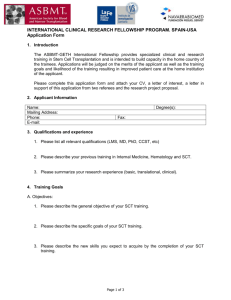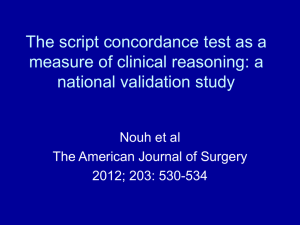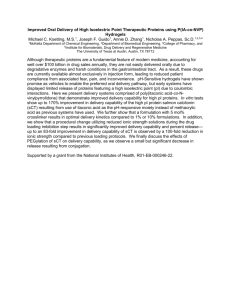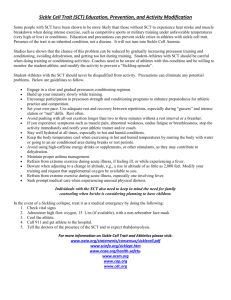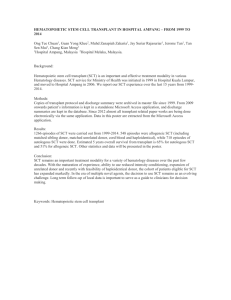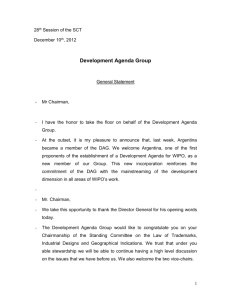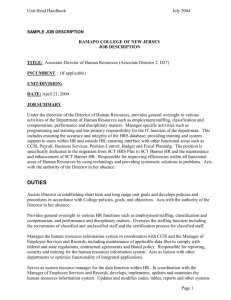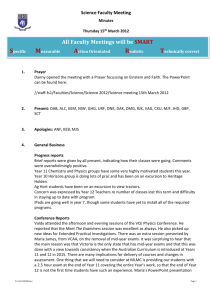patentmath-US-Supreme-Court-and
advertisement
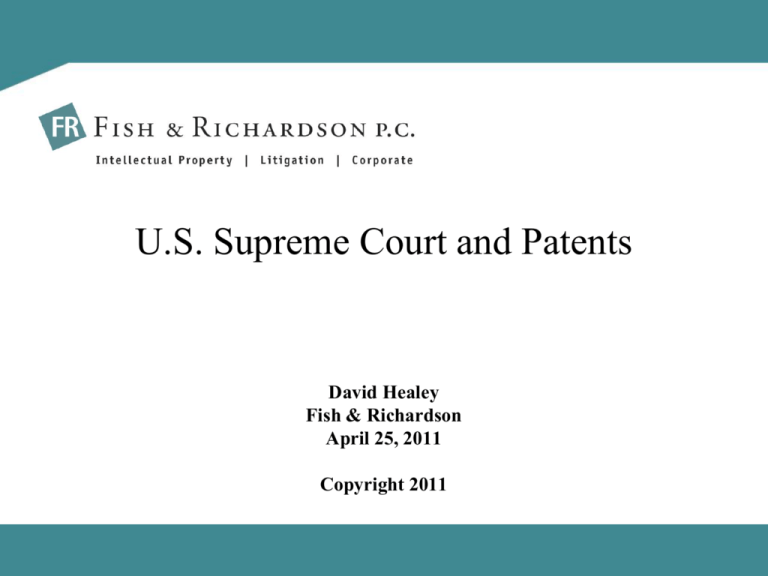
U.S. Supreme Court and Patents David Healey Fish & Richardson April 25, 2011 Copyright 2011 But first a word on behalf of our GC This talk and these slides are for discussion purposes only. The content of the slides and talk are meant to promote discussion, thought, and are not intended to be opinions or statements of the law on any set of facts. The presentation does not reflect the opinions of Fish & Richardson in any specific case. For copies under these conditions, email healey@fr.com For Discussion Only, Not Legal Advice, Per Slide 2 2 US Sct And Patents: The Top US SCT Court of Policy US SCT Rule-Making Federal Circuit Court of Error District court PTO For Discussion Only, Not Legal Advice, Per Slide 2 ITC 3 Sct is Court of Policy Sct takes cases to set policy, not to correct errors. Sct only takes cases according to its own discretion: – Process to request review is called petition for writ of certiorari: – Approx. 10,000 petitions for writ of certiorari filed each year. – Less than 100 writs are granted: Case set for full briefing, argument and an opinion on the merits per term. – The 100 cases cover all fields of Federal Law: Criminal, procedure, administrative law, elections law, disputes between states, as well as appeals from State “high courts” on Federal Issues (typically criminal cases, e.g., death penalty). For Discussion Only, Not Legal Advice, Per Slide 2 4 Sct is Court of Policy Sct might know a case is wrong but not act because it must allocate its work to the most pressing policy issues: Examples of where Sct would not act: – Where facts are unique and not likely to re-occur. – Where question might benefit from further development in courts of appeals. – Legislative solution is required not judicial solution. For Discussion Only, Not Legal Advice, Per Slide 2 5 Sct’s Impact on Patent Cases Review of Federal Circuit opinions on patent law. Review of all Federal Courts of Appeals decisions on procedure (e.g., pleading). Review of antitrust cases through FTC and courts, that impact on patent cases (e.g, standards, reverse settlement payments, tying, patent pools). Constitutional issues that impact judicial system from any source (e.g. standing, personal jurisdiction). Rule-making process for Rules of Civil Procedure. For Discussion Only, Not Legal Advice, Per Slide 2 6 Sct & Policy of U.S. Government Sct asks Solicitor General for the Government’s view when administration of U.S. regulations or agencies is at stake: – For example, in i4i v. Microsoft, the Sct. invited the Solicitor General to give government’s view on the case by filing a brief on the merits and giving oral argument. – Solicitor General is part of the President’s administration. – Often the Solicitor General’s view is given great weight in cases involving federal government agencies and regulations. For Discussion Only, Not Legal Advice, Per Slide 2 7 Sct Meets the Federal Circuit For first quarter century of Federal Circuit, 1982-2005, Sct left patent law to Federal Circuit (7 cases in 23 years). NTP v. RIM injunction against “blackberry” system in 2005 was “wake up call” to the importance of public policy and patents: Why? – August 28, 2005 Hurricane Katrina destroyed most of New Orleans, the “blackberry RIM” system was sole reliable communication: NTP injunction was threat to public safety. – eBay filed petition for review in November 2005, it was granted, and in Spring 2006, Sct decided eBay v. MercExchange to deal with public policy of injunctions. For Discussion Only, Not Legal Advice, Per Slide 2 8 Blackberry Was Critical In Katrina On Larry King show, on national T.V., New Orleans Mayor Ray Nagin, said that in the days following Hurricane Katrina, the only way he could communicate with city officials and employees was by his blackberry. – This was in early September 2005. – November 5, 2005, Sct grants certiorari to review eBay’s complaint that injunctions should not be given out in patent cases unless traditional equitable principles are met. – Ironically, in January 2006, Sct denied RIM’s petition for writ of certiorari on narrower questions that would have avoided an injunction in its case. For Discussion Only, Not Legal Advice, Per Slide 2 9 Recent Sct Cases for Patent Litigators eBay v. MercExchange: Injunctions not mandatory. Twombly and Iqbal: New pleading standards Medimmune v Genentech, DJ actions, standing Bilski v. Kappos: Scope of U.S. patents Holmes v. Vornado: Limitation on jurisdiction of Federal Circuit. KSR v Teleflex: Obviousness standard. Quanta v LG: Patent Exhaustion. Illinois Tool Works, Inc. v. Independent Ink: Tying-Antitrust Microsoft v AT&T: Limit on foreign reach of US laws For Discussion Only, Not Legal Advice, Per Slide 2 10 Pending Decisions and Petitions Argued, briefed and opinion pending this term: – i4i v Microsoft – SEB/ Therasense – Stanford v Roche Petitions for Certiorari filed requesting review: – Mediostream v Microsoft – In re Princo For Discussion Only, Not Legal Advice, Per Slide 2 11 The Most Important Sct Decision In the last five years the most important Sct decision in patent law is eBay v. MercExchange L.L.C., 547 U.S. 388 (2006): This case was politically charged due to Hurricane Katrina. This case changed all patent law since the 1952 Patent Act, by holding that a patent owner who won its case still had to meet the traditional test under principles of equity for an injunction. This case eliminated the mandatory injunction in patent cases: This case made injunctions the exception not the rule. For Discussion Only, Not Legal Advice, Per Slide 2 12 Most Important Sct Decisions Holmes Group, Inc. v. Vornado Air Circulation Sys., 535 U.S. 826 (2002): – Held that the jurisdiction of the Federal Circuit Court of Appeals was limited to cases where the original complaint was brought based on the patent jurisdiction statute. – And that the Federal Circuit could not take jurisdiction over a case simply because it had a patent issue in the lawsuit. – This decision allows litigants to frame their original filings in antitrust and other lawsuits to avoid the Federal Circuit on appeal. • This is important because the Federal Circuit is very pro-patent. • E.g., in Reverse payment settlements, Federal Circuit rule permits them while other courts of appeals condemn or limit them. For Discussion Only, Not Legal Advice, Per Slide 2 13 Most Important Sct Decisions Ashcroft v. Iqbal, 556 U.S. ___, 129 S.Ct. 1937 (2009); Bell Atlantic Corp. v. Twombly, 550 U.S. 544 (2007) These decisions changed the pleading standards under Federal Rule of Civil Procedure 8 on pleading: – In patent cases, for 271(b) Inducement and 271(c) contributory infringement, the complaint must set forth facts that are plausible that if true would state a cause of action. “Bare bones” pleading is no longer allowed. – For 271(a) direct infringement, these opinions do not apply because Federal Rule of Civil Procedure 84 and Form 18, specifically set minimum standard for pleading direct infringement in a patent case. For Discussion Only, Not Legal Advice, Per Slide 2 14 Most Important Sct Decisions Medimmune, Inc. v. Genentech, Inc., 549 U.S. 118 (2007) Changed standard for filing a declaratory judgment action. Changed rule that licensee had to give up license to challenge validity (licensee estoppel). Held that any act that was taken to exploit a patent could be the basis of a “DJ” action (law previously required an express threat of suit). For Discussion Only, Not Legal Advice, Per Slide 2 15 Most Important Sct Decisions Bilski v. Kappos, 130 S. Ct. 3218, 3225 (2010) Held Section 101 of Title 35 allowed for broad range of inventions that could be patented. Upheld business method and software patents as patentable “processes”. Rejected Federal Circuit’s “machine or transformation” test. Only three exceptions to patentable subject matter: – laws of nature – physical phenomena, and – abstract ideas. For Discussion Only, Not Legal Advice, Per Slide 2 16 Most Important Sct Decisions KSR Int'l Co. v. Teleflex, Inc., 550 U.S. 398 (2007) "A person of ordinary skill is also a person of ordinary creativity, not an automaton.” – Eliminated requirement of suggestion of a teaching that references be combined to make the claimed invention – Obviousness under Section 103 could be based only on a single, incomplete reference where a person of ordinary skill in the art would have thought to fill in or adapt missing parts. For Discussion Only, Not Legal Advice, Per Slide 2 17 Most Important Sct Decisions Quanta v. LG, 553 U.S. 617 (2008) When are the rights of a patent owner exhausted by its sale of a product where use of the patented invention is the expected use of the product? – Method claims are exhausted when the expected and intended use of a product sold by the patent owner or its licensee is to employ the patented method. – This restated long-standing Sct law that patent rights are exhausted by sale of a patented product. (U.S. v. Univis Lens) For Discussion Only, Not Legal Advice, Per Slide 2 18 Most Important Sct Decisions Illinois Tool Works, Inc. v. Independent Ink, 547 U.S. 28 (2006) Antitrust case on “tying” involving patents. Antitrust laws protect markets not competitors or products. Generally, must show a contract or conspiracy is an “unreasonable restraint” on trade in a “relevant market”. Sct made clear a patent does not ordinarily define the market. Tying requires proof of harm to competition in a relevant market. For Discussion Only, Not Legal Advice, Per Slide 2 19 Most Important Sct Decisions Microsoft v AT&T, 550 U.S. 437 (2007) – Shipment of a “Golden Disk” with software outside of the U.S. to be combined with hardware and other software to make something that would infringe a U.S. patent if made or sold in the U.S. is not covered by reach of U.S. patent law. – Even though 271(f) does not permit circumvention of U.S. patent by assembling components of an infringing device outside of the U.S., 271(f) does not reach this conduct because the software is not a component. For Discussion Only, Not Legal Advice, Per Slide 2 20 Pending Cases in Sct For Discussion Only, Not Legal Advice, Per Slide 2 21 Opinion on Merits Pending in the Sct SEB/Therasense, Argued February 23, 2011: – DSU Medical held in 2006 that inducement required knowledge of the patent and a deliberate effort/intention to cause another to actually infringe the claims of the patent. – SEB/Therasense later held in 2010 that inducement could occur where there was “deliberate ignorance to a known risk”, not just proof of knowledge. – “Deliberate ignorance” is generally a criminal law doctrine used in prosecution for smuggling and possession of contraband: “Someone paid me $1,000 to carry this suitcase on to the plane, I don’t know what is in it – he did not tell me and I did not ask.” – No involvement by Solicitor General. For Discussion Only, Not Legal Advice, Per Slide 2 22 Opinion on Merits Pending in the Sct Stanford v. Roche, Argued February 28, 2011 – Ownership of inventions, standing and the Bayh-Dole Act. – Whether a federal contractor university's statutory right under the Bayh-Dole Act, 35 U.S.C. §§ 200-212, in inventions arising from federally funded research can be terminated unilaterally by an individual inventor through a separate agreement purporting to assign the inventor's rights to a third party. – Solicitor General was asked to file a brief and argue. For Discussion Only, Not Legal Advice, Per Slide 2 23 Opinion on Merits Pending in the Sct i4i v. Microsoft, Argued April 18, 2011 – Should clear and convincing test for invalidity in patent litigation be reduced to “preponderance of the evidence”? • Final administrative agency action is generally only subject to limited review, much like clear and convincing standard. • Solicitor General asked the Sct to uphold clear and convincing standard in all cases. • Microsoft focused on reducing the standard where the USPTO did not consider the materials on which invalidity is based: e.g., on-sale bar. • Practical impact on a jury trial will be small – real impact is on JMOL and appeal from trials. • Questionable if any impact on MSJ since standard is “as a matter of law”/”no factual dispute”? For Discussion Only, Not Legal Advice, Per Slide 2 24 Pending Cert Petitions in Sct Mediostream v Microsoft: Petition for writ of certiorari on standard of review of a district court’s decision on transfer of a lawsuit under Section 1404(a) of Title 28. – Mediostream was an EDTEX case under Fifth Circuit 1404(a) law. – Mediostream has petitioned for Sct review of a Federal Circuit mandamus, arguing that there is a split among the circuit court of appeals on how and whether district court decisions on discretionary transfers can be reviewed. – Asks the Sct to adopt the same rule for all circuits: One where district court decisions not subject to review on facts and only limited review on law as applied to the facts. For Discussion Only, Not Legal Advice, Per Slide 2 25 Pending Cert Petitions in Sct In re Princo: petition for writ of certiorari from divided en banc Federal Circuit decision on scope of patent misuse. Majority held that patent misuse defense only applied to a patent the accused infringer did not want to license and did not infringe (“tied” patent). Since defendant was sued only on the infringed patent, no misuse defense. Dissent wrote that this decision let patent pools and patent licensors violate antitrust law, but still enforce patents. This is especially important in ITC cases where there are no counterclaims, only defenses. For Discussion Only, Not Legal Advice, Per Slide 2 26 End of Presentation This presentation is for discussion purposes only and not a statement of the law or an opinion on any case or set of facts, and is not legal advice. For Discussion Only, Not Legal Advice, Per Slide 2 27
